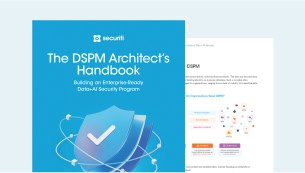Artificial Intelligence (AI) is both a significant threat and a crucial defense in ensuring data security. AI is rapidly altering the threat landscape, powering cybersecurity defense, and integrating with data security tools. However, as organizations begin to embrace AI coupled with automation, one critical aspect remains a cause for concern: ensuring data security.
Research by PwC indicates that the AI industry is expected to contribute $15.7 trillion to the global economy by 2030. At the same time, AI and ML automation have improved operational efficiency by an average of 40% across sectors.
The close relationship between AI and automation hinges on their shared potential to simplify complex processes, minimize human error, and expedite innovation and decision-making, enabling enterprises to function more effectively, respond to threats more quickly, and scale up their operations.
Challenge: The Growing Threat Landscape
The core challenge organizations face is ensuring their data collection, processing, storage, and sharing practices comply with evolving AI and data privacy requirements. As data privacy regulations evolve, so must an organization’s data security posture to minimize exposure to regulatory scrutiny, costly noncompliance fines, or reputational damage.
Another challenge is the increasing threat landscape. Data is the lifeblood of most modern organizations, attracting malicious actors and an escalation in data exposure that threatens the confidentiality, integrity, and availability of data. Cyber threats are at an all-time high, and the annual average cost of cybercrime is predicted to exceed $23 trillion by 2027, up from $8.4 trillion in 2022.
As cyber threats evolve and multiply, traditional legacy security models —often manual, error-prone, and reactive —are proving inadequate. This is where AI and automation, two transformative forces, are revolutionizing the data security landscape.
AI: The Intelligent Security Sentinel
AI is transforming security automation by rapidly analyzing vast volumes of data to identify potential threats and vulnerabilities. With time, AI-driven systems become more effective at detecting threats as they learn and adapt. AI, coupled with automation, reduces reaction times and the effort of the security team by acting instantly against discovered threats and provides predictive analysis, allowing for proactive defenses. AI enhances data security via:
A. Anomaly Threat Detection and Prediction
AI operates at lightning-fast speeds, enabling it to swiftly analyze vast amounts of data stored in on-premises, cloud, and hybrid cloud environments to identify anomalies and potential threats in real-time. Threats that deviate from the normal are then flagged, giving targeted visibility into the threat landscape.
Additionally, AI is continuously learning from behavioral patterns, enabling AI systems to predict attacks with higher accuracy before such attacks escalate or occur, thereby transforming security from a reactive to a proactive approach.
B. Predictive Analytics
AI is data hungry, meaning it uses past and present data to make informed decisions about the future. By analyzing past breach incidents and patterns, AI can more accurately predict threats and provide threat intelligence that is crucial to enhancing an organization’s data security posture.
C. Behavioral Analytics
AI leverages a combination of patterns to make a solid judgment. It doesn’t rely on a single source of data. Instead, it collects, measures, and analyzes vast volumes of data to understand how users, customers, or systems behave over time. AI leverages user and entity behavior analytics (UEBA) to identify deviations from normal behavior, enabling security teams to detect insider threats, compromised credentials, and advanced persistent threats with greater accuracy.
D. Faster Incident Response
AI-driven Security Orchestration, Automation, and Response (SOAR) platforms can automate the triage of alerts by distinguishing between genuine threats and false positives, prioritizing risks, and even initiating containment actions, reducing the mean time to detect (MTTD) and mean time to respond (MTTR). This reduces the workload on human analysts and ensures critical threats are addressed immediately.
Automation: Scaling Security with Precision
Automation is the powerhouse that provides scalability by eliminating traditional, manual processes that are not only time-consuming but also prone to error. Automation enables enterprises to streamline processes that are core to ensuring data security, such as:
A. Data Discovery and Classification
Automation tools can continuously scan structured and unstructured data repositories to identify sensitive data, such as personally identifiable information (PII), protected health information (PHI), and financial data, across both cloud and on-premises environments. This visibility is foundational to enforcing security and privacy controls.
B. Automated Incident Response
Automation accelerates incident response to meet data breach notification requirements, ensuring compliance with both impacted individuals and regulatory bodies.
C. Data Security Workflow Automation
Having robust guardrails and authentication protocols is core to ensuring data security. Automation streamlines repeatable tasks that traditionally require human intervention, thereby improving operational efficiency and quality.
D. Policy Enforcement
Automated enforcement of data security policies ensures consistent application of access controls, encryption standards, and data minimization across the organization, reducing the risk of human error.
E. Compliance Monitoring
Regulations such as GDPR, CCPA, and HIPAA require continuous compliance. Automation enables real-time monitoring, audit readiness, and automated reporting, turning regulatory obligations into operational workflows.
The Synergy of AI and Automation in Data Security
Together, AI and automation are the driving forces that enable organizations to achieve autonomy, resilience, and scalability in their data security efforts and systems. They seamlessly complement each other to deliver the following:
- Autonomous data intelligence to discover and catalog data across on-premises, cloud, and hybrid cloud environments
- The ability to expedite compliance with evolving regulatory requirements, such as honoring data subject rights, ensuring data minimization and purpose limitation, impact assessments, etc
- The ability to scale data security operations across geographies and ensure robust data governance
Although both AI and automation promise benefits, it is hard to ignore a few challenges that organizations may encounter, such as bias in AI models leading to inaccurate results and predictions, overlooking threats due to over-reliance on automation, and neglecting how cybercriminals may utilize AI and automation to carry out cyberattacks.
Consequently, organizations must implement a strong data governance framework to prevent unintended access and manage these risks effectively. Large-scale enterprises are beginning to see the increasing value AI and automation can bring to their business operations. Hence, they are actively engaging stakeholders in making strategic advancements in their businesses to maximize future value from AI and automation. Discover how organizations are developing safe enterprise AI.
Enhance Your Data Security Posture with Automation
Securiti is the pioneer of the Data Command Center, a centralized platform that enables the safe use of data and AI. It provides unified data intelligence, controls, and orchestration across hybrid multicloud & SaaS environments. Large global enterprises rely on Securiti's Data Command Center for data security, privacy, governance, and compliance.
The platform offers a built-in DSPM solution that enables organizations to secure sensitive data across multiple public clouds, private clouds, data lakes and warehouses, and SaaS applications, protecting both data at rest and in motion.
Organizations can leverage contextual data intelligence and controls to discover and classify data, minimize ROT data risk, reduce misconfiguration vulnerabilities, prevent unauthorized data access, understand data flow, and enforce consistent security controls across the data journey, including real-time streaming data, in addition to managing compliance and breach risk.
Request a demo to learn more.











































